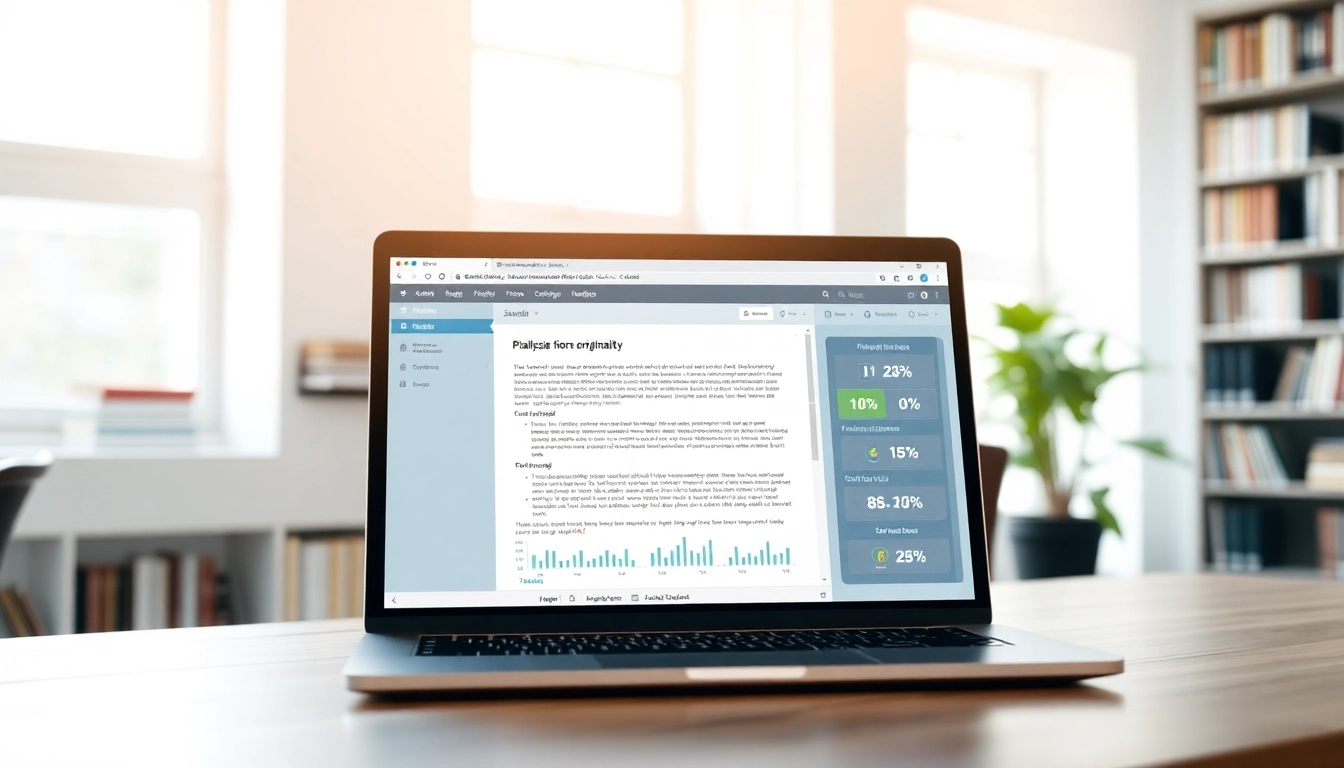Understanding Plagiarism and Its Consequences
Plagiarism, a term that often evokes a strong response in academic and creative circles, refers to the act of using someone else’s work, ideas, or intellectual property without proper attribution. As technology advances, the ease of copying content has increased, making it essential to understand what constitutes plagiarism, its implications, and how to avoid it. One of the best ways to safeguard against unintentional plagiarism is to use a reliable plagiarism detector. This tool can help individuals at any academic level ensure their work maintains integrity while fostering original thought.
What Constitutes Plagiarism?
Plagiarism is not only about copying text verbatim. It can take several forms, including:
- Direct Plagiarism: Copying another person’s work word-for-word without quotation marks or citation.
- Self-Plagiarism: Submitting one’s previous work as if it were new, which can happen in academic territories where students resubmit past essays or research.
- Paraphrasing Plagiarism: Rewording someone else’s ideas without crediting the original source, which can often go unnoticed but is still considered unethical.
- Accidental Plagiarism: Unintentionally failing to cite sources correctly or misplacing quotation marks can also result in plagiarism charges.
The Importance of Academic Integrity
Academic integrity is the foundation of scholarly work, where honesty, trust, fairness, respect, and responsibility guide interactions and assessments. Upholding these values is crucial for maintaining the reputation of educational institutions and the credibility of academic qualifications. Plagiarism undermines these principles, leading to disciplinary actions that can range from failing an assignment to expulsion. Therefore, understanding and preventing plagiarism is essential for students, professionals, and educators alike.
Common Misconceptions About Plagiarism
Misinformation about plagiarism abounds, leading many to false assumptions. Here are some common misconceptions:
- “I can use quotes as long as I cite them.” – While using quotes is allowed with proper citation, excessive quoting can also be viewed as plagiarism if it overshadows original content.
- “If I change a few words, it’s not plagiarism.” – Merely rephrasing another’s ideas without attribution does not make it original content.
- “Plagiarism only matters in academia.” – Plagiarism can have serious legal consequences in professional and creative industries as well.
How Plagiarism Detectors Work
Understanding the technology behind plagiarism checkers gives insight into their necessity and effectiveness. These tools have become imperative for students and professionals who wish to maintain originality in their work.
Technology Behind Plagiarism Detection
Plagiarism detectors analyze text utilizing advanced algorithms and databases. They often employ:
- Text-matching Technology: This scans submitted texts and compares them against vast databases of published material.
- Machine Learning Algorithms: Sophisticated software learns from patterns in writing, capable of differentiating between unique expressions and those that are plagiarized.
- AI-Based Solutions: Modern plagiarism detectors incorporate AI to identify unique writing styles and establish context, offering a broader understanding of potential plagiarism.
Types of Content Checked by Detectors
Plagiarism detection tools can assess various types of content, including:
- Academic Papers: Essays, theses, and dissertations are commonly submitted for review.
- Creative Works: Articles, blogs, and even poetry can be measured against existing materials.
- Codes and Software: There are specific detectors for programming codes to detect similarities and potential copyright infringement.
Limitations of Plagiarism Detectors
While plagiarism detectors are helpful, they come with limitations:
- False Positives: These tools can mistakenly identify legitimate citations or common phrases as plagiarism.
- Limited Databases: Not all detectors have access to all sources, potentially missing some instances of plagiarism.
- Quality of Detection: Some tools are less effective in distinguishing between paraphrased content and original writing.
Choosing the Right Plagiarism Detector
Selecting an appropriate plagiarism detector is crucial to achieving reliable results. Here are factors to consider when making your choice.
Key Features to Look For
When evaluating plagiarism checkers, consider the following features:
- User-Friendly Interface: An intuitive interface allows easier navigation and quick results.
- Database Size: Larger databases enhance the likelihood of identifying plagiarized content.
- Real-Time Analysis: Instant feedback is critical for timely revision and improvement.
- Comprehensive Reports: Detailed reports showing similarity percentages and sources provide useful insights for users.
Cost vs. Free Options
While many plagiarism detectors offer free services, premium versions typically provide more features and higher accuracy. Consider the following aspects:
- Budget Constraints: Assessing your finances may influence whether you opt for a free service or invest in a comprehensive tool.
- Trial Periods: Some paid options offer trial periods, allowing users to gauge efficacy before committing.
- Upgrade Potential: As your academic or professional needs change, consider the scalability of the tool.
User Reviews and Recommendations
User experience plays a vital role in determining the reliability of plagiarism detectors. Seek out:
- Peer Recommendations: Colleagues or fellow students can provide insights based on their experiences.
- Online Reviews: Platforms that aggregate user reviews can offer unbiased perspectives.
- Performance Metrics: Assess tools based on reported effectiveness and speed of detection.
How to Effectively Use a Plagiarism Detector
Employing a plagiarism detector effectively involves understanding how to analyze your work and implement the feedback received. Here’s a guide to maximizing your use of these tools.
Steps to Analyze Your Work
- Prepare Your Document: Ensure your work is complete and formatted properly for the detector.
- Input Your Text: Copy and paste or upload your document into the plagiarism detector’s interface.
- Initiate the Scan: Start the plagiarism check, allowing the tool to analyze your work against its database.
- Review Results: Examine the report for highlighted sections, percentage matches, and potential sources.
Interpreting the Results
Understanding the results from a plagiarism detector is crucial for effective revision:
- Identifying Sources: Review matched content against specified sources to determine if proper citations are needed.
- Assessing Similarity Index: A high similarity percentage indicates the necessity of revisions, while low percentages are preferable.
- Documenting Changes: Keep records of citations and revisions made to enhance the integrity of your work.
Best Practices for Original Writing
To minimize the chances of plagiarism, adhere to the following best practices:
- Use Quotations Effectively: When borrowing phrases or sentences, ensure you quote them correctly.
- Maintain a Distinct Writing Style: Cultivating your unique narrative voice can help reduce unintentional borrowing.
- Engage in Thorough Research: Relying on varied sources enhances your understanding of the topic and contributes to original writing.
Improving Your Writing Skills to Avoid Plagiarism
Enhancing writing skills not only reduces the risk of plagiarism but also enriches academic and professional communication. Below are methods to cultivate originality in your writing.
Research Methods for Original Ideas
Employing efficient research methodologies can lead to fresh insights and ideas:
- Diverse Sources: Utilizing a variety of sources expands the perspectives you can draw from in your writing.
- Note-taking Techniques: Employ systems such as the Cornell method or mind mapping to capture ideas and inspiration effectively.
- Engaging with Experts: Interviews or discussions with knowledgeable individuals can provide unique angles on a topic.
Effective Paraphrasing Techniques
Paraphrasing is a skill that requires practice and understanding of the original content:
- Read Before Writing: Fully understand the material before attempting to rewrite it.
- Use Your Own Words: Focus on expressing the ideas in ways that reflect your voice.
- Check with a Plagiarism Detector: Always verify that your paraphrased text maintains originality before finalizing your work.
Utilizing Citations Properly
Proper citation is essential for maintaining academic integrity:
- Know Citation Styles: Familiarize yourself with different citation styles such as APA, MLA, or Chicago, based on academic requirements.
- Track Sources: As you conduct research, keep a meticulous record of all sources consulted.
- Use Citation Tools: Leverage citation management software to streamline the citation process and reduce errors.



